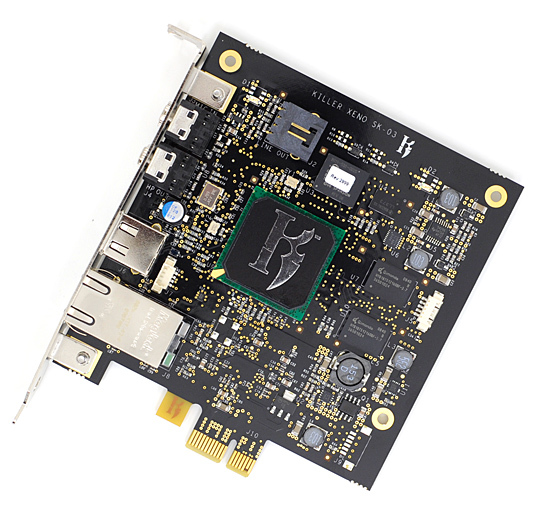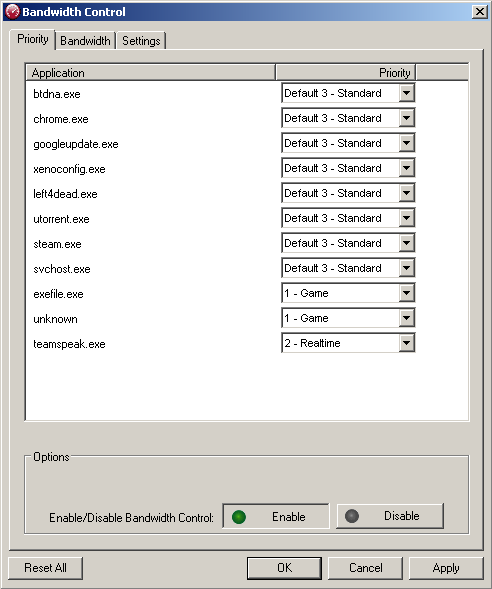EVGA Killer Xeno Pro: The Impact of Network Offloading
by Derek Wilson on July 3, 2009 4:20 AM EST- Posted in
- Networking
The Card and Features
This card sports a 400MHz PowerPC processor with 128MB of RAM, essentially making the Killer Xeno Pro a computer on a x1 PCIe board. As with the first generation, the major feature of the Killer Xeno Pro is it's ability to offload TCP/IP work from the CPU by bypassing the Windows TCP/IP stack.
Microsoft's built-in TCP/IP stack requires the CPU to handle network packet processing. Additionally, when packets arrive, they don't generate interrupts and applications must poll for data (which also wastes time and resources). Bigfoot Networks claims that the windows networking stack is not designed for low latency operation while the Killer Xeno Pro is. Regardless of how (or how efficiently) a software network stack is implemented, having it run in hardware will reduce overhead and impact on the rest of the system. It should also be noted that, for applications which require the windows networking stack (like some VPN products), the Killer Xeno Pro can disable it's "game mode" and enable "application mode" which does disable TCP/IP offload and can increase compatibility in some cases.
Adding to this, the Killer Xeno Pro hardware is capable of offloading other network centric tasks like VoIP, firewalls, and networked storage (though these features are not all fully supported with appropriate software at this point in time).

Installing the hardware is very straight forward, as it's just a simple PCIe card. If you want to use the voice chat features, the only additional need is to connect either the internal or external audio cable. No power is required, and other than that the network port is all that you'll need to worry about. Despite the fact that there is a USB port on the card, it is not used for anything at this point (but Bigfoot has indicated future potential to enable hardware managed USB attached storage).

Mic in and audio line out on a NIC; now that's a first.
The only installation issue we noted is that the driver install, when necessary, will also flash the Killer Xeno Pro hardware. There isn't very much warning about what's going to happen and no confirmation dialog before the start of the flash process. Those who click through install programs quickly without reading them might get themselves into a bit of trouble. There is no way to cancel the flash update once it's started, and while flashing hardware isn't as risky these days, it might be nice if the drivers were a little more clear about what was going to happen.

Easy mode switching.
The hardware comes with drivers and a tray application that are capable of bandwidth throttling and prioritization. Control can be down to a per application basis and maximum download and upload speeds can be specified. Or for benefit without the headache, applications can be prioritized allowing hardware and usage patterns to determine effective bandwidth. Unfortunately, the drivers and applications for the Killer Xeno Pro only run on Microsoft Windows operating systems (XP and Vista flavors). With the gaming focus, this makes sense, but it would still be nice for those who like to dualboot Mac OS X or Linux.

Per application QoS.

Per application bandwidth limits.
With software support, games and voice chat software can completely delegate any VoIP functionality to the Killer Xeno Pro which would handle taking input from the microphone (which plugs straight into the Killer Xeno Pro), compressing the data and sending it out over the network. When a voice packet is received by the Killer Xeno Pro, it decompresses it and sends it straight to the sound card (either via the soundcard's line-in port or an internal cable) bypassing the rest of the system completely. This should help reduce CPU overhead and voice lag caused by sources other than the network or server.
While this is great from a geeky technical standpoint, there isn't a huge amount of overhead on modern CPUs for voice chat software, and the network is by far the largest source of delay. So the actual benefit isn't going to be huge. These issues are the same with hardware firewall, bandwidth control, and all the extras.
The TCP/IP offload capability of the hardware will definitely remove another task from the CPU and operating system. This will free up resources that could be useful for other things, but the real world benefit of this will be very small in most games where the majority of the work is done on the GPU rather than the CPU. Having an NPU (network processing unit, as Bigfoot Networks likes to call it) that handles TCP/IP processing as soon as packets are received and uses hardware interrupts to let a game know that network packets have arrived (rather than requiring polling) can help decrease the latency between when a packet is received by the network card and when a game is able to make use of it, but as with the voice issue the largest delay is inherent in the internet itself and there is only so much benefit that can be had by optimizing the client side.
Not to say that optimizing client side networking is a bad thing: it certainly is not. The real question here is not whether the Killer Xeno Pro does something useful (because it does), the question is whether that useful thing has any significant impact on experience (and if that impact is high enough to justify the price).










121 Comments
View All Comments
marsbound2024 - Friday, July 3, 2009 - link
"Let's start by saying that this isn't going to be a network card for someone hanging on to a 7 Series NVIDIA card or a Radeon 1k part from ATI in a single core CPU system."Dang...did you guys sneak into my house last night and check out my computer? I've yet to upgrade from my antiquated 7600GT, Athlon64 3800+ 2.4GHz single-core processor! The time to upgrade is nigh though. I've been hanging on to that system for a while now because it does everything I need it to at the moment with Windows XP. After work, I don't really care about coming home and doing anything CPU intensive on my PC and I play my games on console. However, Crysis Warhead and such have led me to continue to want to get a new system.
Atechie - Friday, July 3, 2009 - link
1. Eve Oneline is TCP, games that benefit are UDP based.2. "Since we can't get an assessment of ping times in EVE, we did some testing on WoW in the same unpopulated area. Normalized to the average latency we experienced while not downloading a torrent, here's the latency incurred by downloading a torrent"
Unpopulated, not stressing area...why bother is yoo are going to scew the test?
3. Clueless reviewer
4. profit?
Looking at this test it almost look as it was meant to be a less than stellar test
DerekWilson - Friday, July 3, 2009 - link
The killer benefits both UDP and TCP games ... not just one or the other.We tested in an unpopulated area in WoW in order to keep things as deterministic as possible. Some of the tests we ran were not strictly deterministic, but it is incredibly hard to construct tests that work in populated areas that generate usable data at all.
the WoW test, even in an unpopulated area, did show that there is a difference in network performance while downloading a torrent. We didn't see this sort of difference while not downloading a torrent, however.
The real issue is that proper testing almost needs to be in a clean room sort of environment where multiple scenarios can be played back across the network and on the PC to show what the actual differences in performance would have been.
But even when that shows some actual performance differences (as I believe it would) the benefits just don't present themselves to the end user in any truly beneficial way.
DigitalFreak - Friday, July 3, 2009 - link
Quit your whining. Derek has already responded to these issues.hooflung - Friday, July 3, 2009 - link
And Derek was wrong. At least I am not the only one who pointed this out.DerekWilson - Friday, July 3, 2009 - link
Once again --EVE uses both TCP and UDP and not just TCP. WoW, it seems by all accounts I can find online, uses only TCP.
Aside from this, the Killer hardware accelerates both TCP and UDP not just one or the other, so the whole issue doesn't matter one bit.
stmok - Friday, July 3, 2009 - link
While I can see why they tried to target the gaming market, it just feels like its more suited for server or hacker/enthusiast audience. (So I agree with the author in that regard.)The irony of this product is that, while it uses an embedded version of Linux on the NIC, it isn't fully supported under Linux! ie: Say if you used Ubuntu, OpenSUSE, or "whatever is your fav distro" in your system; you wouldn't be able to have full access to all its features! Its a "Windows only" thing!
The product has potential...It just feels the company is focusing on an audience who won't really appreciate what the product can do. Its kind of wasted in that sense.
trochevs - Friday, July 3, 2009 - link
I agree. Until they open the access to the embedded OS and other people and hackers develop apps for it it will be doomed.If I had access to the hardware I would install scaled down version of my web server LAMP and shutdown the main PC. If the traffic jumps I would wake the main server and handle the demand.
Other cool use could be to upload the Asterisk and have 24/7 VoIP PBX without the need to run the PC 24/7
How about to run my torrent server without running the PC.
And the end. Keep the PC in hibernate and when I need it for remote access I can connect to the NIC and wake it up.
This has wonderful potentials, but until Xeno executives wake up from their dream to become the next Gates or Jobs with proprietary platform this would be yet one more great idea and impressive engineering that never going to see light of the day.
Open platform please. Just like the PC.
Stas - Friday, July 3, 2009 - link
Would be silly to bother with support for Linux when this is marketed as a GAMING product. Windows makes sense.stmok - Saturday, July 4, 2009 - link
"Would be silly to bother with support for Linux when this is marketed as a GAMING product. Windows makes sense."=> What kind of gamer would take the time to download the SDK for this product and help develop applications for the hardware?
This is EXACTLY what I mean when I say the product is aimed at the wrong market. Gamers won't bother. Gamers aren't developers.
Than again, how much sense does Windows make when you are replacing its network stack with this?